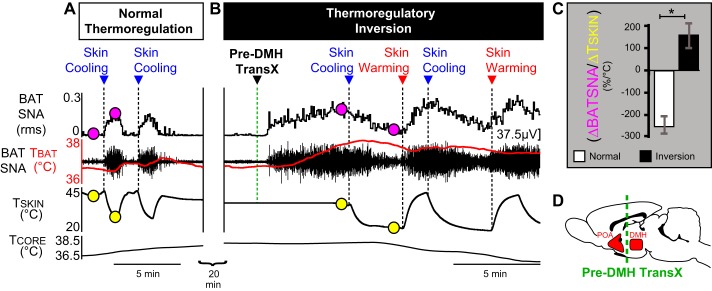Fig. 1.
Predorsomedial hypothalamus (DMH) transection, which eliminates the rostral hypothalamic input from downstream brain structures, induces a dramatic thermoregulatory inversion. A: a naïve rat exhibiting normal thermoregulation in which skin cooling produces a strong and repeatable increase in brown adipose tissue (BAT) sympathetic nerve activity (SNA) and BAT temperature (TBAT; red trace), whereas skin rewarming inhibits BAT SNA and reduces TBAT. B: after a pre-DMH transection, the same rat exhibits thermoregulatory inversion, in which skin cooling produces strong and repeatable inhibitions of BAT SNA and falls in TBAT, whereas skin rewarming elicits prompt and repeatable increases in BAT SNA and TBAT. Circles indicate the 2 points corresponding to the zenith and nadir of TSKIN values in the recordings in the naïve rat (A) and after the pre-DMH transection (B) at which respective BAT SNA (pink circles) and TSKIN (yellow circles) values were taken to calculate the gain (C; ΔBAT SNA/ΔTSKIN) of the skin-cooling response transfer function during thermoregulatory reflex responses under conditions of normal and pre-DMH transection. The change in sign of the gain of the skin-cooling transfer function from negative values under conditions of normal thermoregulation (A) to positive values following pre-DMH transection (B) reflects the transition to a state of thermoregulatory inversion. D: schematic of a midline sagittal section of the rat brain illustrating the relative positions of the preoptic area (POA), the pre-DMH transection (dashed green line), and the DMH. TSKIN, skin temperature; TCORE, core temperature; rms, root mean square.

